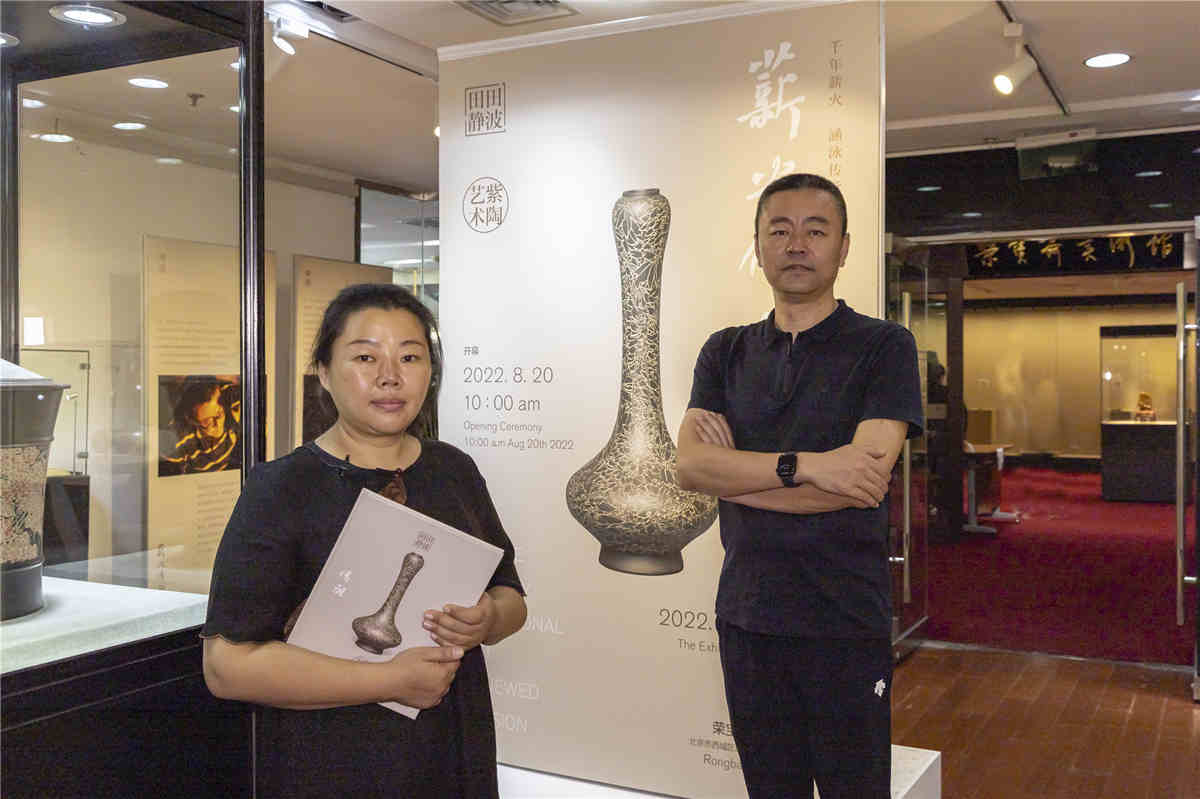Purple Pottery Lifestyle

The Beauty of Purple Pottery
From August 20 to 24 this year, the art exhibition “Inheritance of Fire: Purple Pottery by Tian Bo and Tian Jing” was held at Rong Bao Zhai Art Gallery. It was the first Beijing solo exhibition for purple pottery from Jianshui County, Yunnan Province. The show featured more than 60 pieces by Tian Bo and his younger sister Tian Jing. Their works looked elegant and pure, and the atmosphere of the exhibition was quiet and peaceful, capturing the primitive and unsophisticated beauty of purple pottery and its rich cultural value.
Purple pottery has been produced in Jianshui County for thousands of years. In 1953, it was listed as one of the four famous types of Chinese pottery alongside violet sand earthenware of Yixing, Ningxing pottery of Qinzhou, and Rongchang pottery of Chongqing. In 2008, Jianshui purple pottery’s firing technique was included in the second group of national intangible cultural heritage.

Purple pottery teapots, 2020. (Photo by Chen Jian/China Pictorial)
Officially recognized by the Yunnan Provincial Government, Tian Jing is a major inheritor of Jianshui purple pottery’s firing skills. After acquiring proficiency in traditional techniques, Tian Jing innovated to create more than 100 new shapes through intense practice over two decades. In the process, she has gradually developed a unique artistic style. Her representative work, a “Fuman” (meaning “a wish for more happiness” in Chinese) teapot displayed at the exhibition, is most notable for its extraordinary handle. Based on her decades-long practice, Tian Jing laid out the main theory behind 108 procedures for making purple pottery including 12 processes for scouring the clay, 72 processes for molding, and 24 processes for firing, which helps guide new practitioners in the industry. In contrast with Tian Jing, her elder brother Tian Bo, a senior craftsman in Yunnan Province, excels at traditional firing skills with the firewood kiln. After inheriting the traditional kiln skill of color changing from true red to true purple, he developed a wider variety of color changes such as golden, purple-golden, crack patterns, and net firescale patterns. His pottery works are known for exquisite color changes on unsophisticated, elegant, and very artistic pieces. During this exhibition, the Pot with Peacock Color Change that Tian Bo completed in 2020 was a particular standout. The peacock depicted on the outer wall was carved with a plethora of lines: The craftsmanship is exquisite and vivid.
Historically, Jianshui purple pottery was once known for the tobacco pipes and steaming pots made with this craft. However, most of the purple pottery works displayed at this exhibition were tea sets and utensils made by Tian Bo and his younger sister. The exhibits connected modern life to Jianshui purple pottery. “Purple pottery is a way of life, and the best way to pass down this traditional craft is making it satisfy the needs of our lives today,” said Tian Jing.

Jianshui purple pottery involves an exquisite process of scouring the clay, molding, firing, and breaking saggars. The raw materials contain
special minerals, which appear purple-red after firing. (Photos courtesy of Tian Jing)
The Revival of Purple Pottery
How to achieve the revival of purple pottery? For Tian Jing, the key lies in people. If more people are making it, the art is alive. Over the years, she has been constantly brainstorming ways to spark more interest in purple pottery and guide more people to learn and make it.
Tian Jing believes that the most important strategy to ensure continued inheritance of purple pottery skills is cultivating a number of professional practitioners, especially from local young people. Since 2009, she began to offer a free training class on purple pottery in Jianshui County to provide skills training for rural youth. So far, more than 300 graduates of the training class have secured employment. Moreover, she established the Purple Pottery Training Center at the end of 2018. A provincial-level training base focused on promoting employment and entrepreneurship among young people, the center has trained numerous professionals and contributed greatly to the protection and inheritance of the traditional skills to make Jianshui purple pottery.

Tian Jing (middle) teaches students the techniques of making Jianshui purple pottery. So far, more than 300 graduates of Tian’s free training class have secured employment, passing down the traditional handicraft. (Photo courtesy of Tian Jing)
Today, a growing number of young people in Yunnan are showing interest in the traditional craft from their hometown. Data shows that in 2004, only a few hundred people were engaged in making Jianshui purple pottery. Today, more than 2,000 purple pottery production and sales enterprises and self-employed entrepreneurs registered in Jianshui County employ more than 40,000 workers.
At the end of 2019, Tian Jing tried something new. She encouraged young apprentices at Tian’s Kiln to set up cooperatives. In her view, developing purple pottery create jobs, which enable local young people to secure employment in their hometown, without the need to travel far away to seek jobs in big cities. While earning incomes from the traditional craft, they can take care of their families. Their contributions make their hometown more and more beautiful, attracting more and more tourists, which in turn makes their incomes higher and higher and their lives better and better.

Tian Bo works in a firewood kiln. Jianshui purple pottery fired in traditional firewood kilns features unique color changes. (Photo courtesy of Tian Jing)
“I hope to inspire young people to develop pioneering ideas,” said Tian Jing. “I provide some basic support and help them gain a firm foothold at the beginning of their entrepreneurship. Their participation provides positive energy for changes in their hometown. The youth are the hope and future. When they have new ideas and inspiration, the country has more hope.”